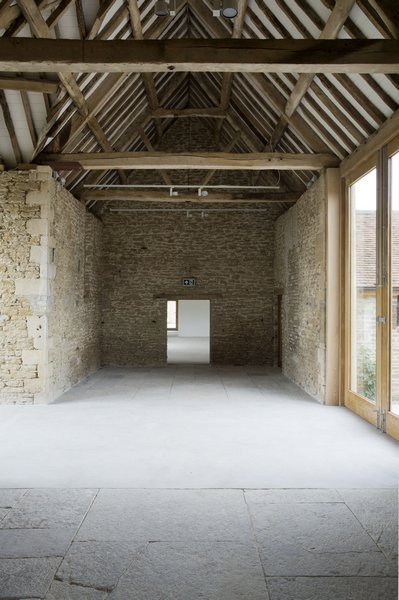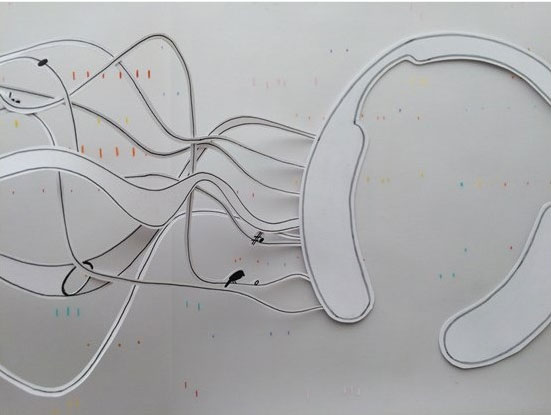If an artist creates a sound, but no one is listening, is it still art? Like performance art, sound art is ephemeral, intangible, and appears to be the next vogue in terms of art experimentation and curation.
But it’s been around in various manifestations since Dadaism, Futurism, and the Surrealists, and came into its own through the compositions of John Cage in the 1950s. One piece of his, entitled 4’33”, is a recording of a pianist walking onto a stage and sitting silently for four minutes and 33 seconds, while coughs and fidgeting can be heard within the concert hall. It touched upon something that is rarely explored in the public’s consciousness: the power of noise. This and other works were fundamental stepping-stones to today’s sound art. The genre was finally coined in 1983, after a landmark exhibition called ‘Sound/Art’ at the Sculpture Center in New York.

The Threshing Barn, Durslade Farm, June 2014: the site of Susan Philipsz’s sound installation ‘As Many As Will’ for Hauser & Wirth
These days, museums have pricked their ears up to the potential of the medium. In 2013, New York City’s Museum of Modern Art (MoMA) held its first major exhibition of sound art, including visualisations of sounds inaudible to humans, and field recordings of a Taiwanese sugar factory. This was also the year that Radio 4 broadcast Artangel’s Open Air series, providing short, visceral bursts of sound art each morning for a week – glitchy, indecipherable interviews by Christian Marclay played on one day, radio static from Peter Strickland on another. More recently, 2015’s editions of Frieze New York and Art Basel provided significant space for audio work, the latter using its Unlimited sidebar as a particular showcase.
There has been plenty of critical recognition, too. In 2010, Susan Philipsz won the Turner Prize for her ballad-based sonic installation, Lowlands, the first aural piece ever to clinch the award. This summer, the Scottish artist was commissioned by taste-making heavyweights Hauser & Wirth to create work for their gallery space in Somerset. In addition, many thought that the 2014 Turner Prize nominee Tris Vonna-Michell was unlucky to not receive the award for his splices of intimate spoken word recordings.
It’s only set to amplify. Now, art schools around the world offer degrees in the genre. The London College of Communication’s BA in Sound Arts and Design centres on ‘the creative use of sound, both as an independent and supportive medium’.

The Sketch of the Score for Sonorama, by Claudia Molitor
A new project by Claudia Molitor, called Sonorama, is further reflective of the genre’s shift to the mainstream. Collating new compositions, spoken word and archival sounds, Sonorama was designed to accompany the train journey between London St Pancras and Margate, offering ‘different points and histories of the line’ and is accessible via an app. What next? The London Underground’s soundtrack to Turnpike Lane?
At a time when portable listening devices and personalised playlists have become the norm, shared aural experiences are becoming rare. The golden age of podcasting shows that there is a niche to be filled. Besides, the rise of sound art could certainly kick-start more careful consideration of our relationship with our ears – why, after all, must we besiege our eardrums at bars, and stand in eerie silence on public transport?
It won’t be long until sound art follows performance art into a more commercial realm. Art fairs will champion it, collectors will buy it. Whether this will dilute sound art’s potency – the poorly received Soundscapes exhibition at the National Gallery, which pits electronic composer Jamie XX with Theo van Rysselberghe’s Coastal Scene (c. 1892), is one example – remains to be heard. But the refinement of the act of listening is certain, and it could leave a lasting impression on our future lives.

The Rise of Sound Art
Chris Watson, one of the contributors to the National Gallery's 'Soundscapes' exhibition
Share
If an artist creates a sound, but no one is listening, is it still art? Like performance art, sound art is ephemeral, intangible, and appears to be the next vogue in terms of art experimentation and curation.
But it’s been around in various manifestations since Dadaism, Futurism, and the Surrealists, and came into its own through the compositions of John Cage in the 1950s. One piece of his, entitled 4’33”, is a recording of a pianist walking onto a stage and sitting silently for four minutes and 33 seconds, while coughs and fidgeting can be heard within the concert hall. It touched upon something that is rarely explored in the public’s consciousness: the power of noise. This and other works were fundamental stepping-stones to today’s sound art. The genre was finally coined in 1983, after a landmark exhibition called ‘Sound/Art’ at the Sculpture Center in New York.
The Threshing Barn, Durslade Farm, June 2014: the site of Susan Philipsz’s sound installation ‘As Many As Will’ for Hauser & Wirth
These days, museums have pricked their ears up to the potential of the medium. In 2013, New York City’s Museum of Modern Art (MoMA) held its first major exhibition of sound art, including visualisations of sounds inaudible to humans, and field recordings of a Taiwanese sugar factory. This was also the year that Radio 4 broadcast Artangel’s Open Air series, providing short, visceral bursts of sound art each morning for a week – glitchy, indecipherable interviews by Christian Marclay played on one day, radio static from Peter Strickland on another. More recently, 2015’s editions of Frieze New York and Art Basel provided significant space for audio work, the latter using its Unlimited sidebar as a particular showcase.
There has been plenty of critical recognition, too. In 2010, Susan Philipsz won the Turner Prize for her ballad-based sonic installation, Lowlands, the first aural piece ever to clinch the award. This summer, the Scottish artist was commissioned by taste-making heavyweights Hauser & Wirth to create work for their gallery space in Somerset. In addition, many thought that the 2014 Turner Prize nominee Tris Vonna-Michell was unlucky to not receive the award for his splices of intimate spoken word recordings.
It’s only set to amplify. Now, art schools around the world offer degrees in the genre. The London College of Communication’s BA in Sound Arts and Design centres on ‘the creative use of sound, both as an independent and supportive medium’.
The Sketch of the Score for Sonorama, by Claudia Molitor
A new project by Claudia Molitor, called Sonorama, is further reflective of the genre’s shift to the mainstream. Collating new compositions, spoken word and archival sounds, Sonorama was designed to accompany the train journey between London St Pancras and Margate, offering ‘different points and histories of the line’ and is accessible via an app. What next? The London Underground’s soundtrack to Turnpike Lane?
At a time when portable listening devices and personalised playlists have become the norm, shared aural experiences are becoming rare. The golden age of podcasting shows that there is a niche to be filled. Besides, the rise of sound art could certainly kick-start more careful consideration of our relationship with our ears – why, after all, must we besiege our eardrums at bars, and stand in eerie silence on public transport?
It won’t be long until sound art follows performance art into a more commercial realm. Art fairs will champion it, collectors will buy it. Whether this will dilute sound art’s potency – the poorly received Soundscapes exhibition at the National Gallery, which pits electronic composer Jamie XX with Theo van Rysselberghe’s Coastal Scene (c. 1892), is one example – remains to be heard. But the refinement of the act of listening is certain, and it could leave a lasting impression on our future lives.
Unlimited access from just $16 every 3 months
Subscribe to get unlimited and exclusive access to the top art stories, interviews and exhibition reviews.
Share
Recommended for you
Art and/or Architecture in Somerset
Can you live in a sculpture? Is good architecture art? Who cares? And which exhibit stands out at Hauser & Wirth’s Architecture Season?
Turner Prize 2014 shortlist announced
Duncan Campbell, Ciara Phillips, James Richards and Tris Vonna-Michell are this year’s nominees
The sound of war: Susan Philipsz’ Broken Ensemble at Eastside Projects
The troubling sounds of five war-damaged instruments are heard for the first time in over 100 years